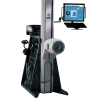
Standardized Stroke Assessments for Rehab
Treatment GuidelinesPatients in this position often have one priority: get back the use of their affected extremity. Stroke assessments like the Fugl-Meyer Assessment of Motor Recovery and the Beck Depression Inventory help clinicians make important decisions in the recovery process.
Standardized stroke assessments are a crucial part of rehabilitation. Stroke patients often present some of the most complex needs that require a great deal of critical analysis from their therapists. Stroke assessments like the Fugl-Meyer Assessment of Motor Recovery and the Beck Depression Inventory help clinicians make important decisions in the recovery process.
The therapist must be aware of many client factors during the first encounter (and every session thereafter). For example, someone with a history of stroke may demonstrate neglect, impulsivity, balance issues, personality changes, memory loss, and more. On top of this, they often have difficulty adjusting to their condition.
Patients in this position often have one priority: get back the use of their affected extremity. The following standardized stroke assessments allow therapists to focus on this (or any other) client-centered goal while still hitting all the major safety concerns patients may display.
Fugl-Meyer Assessment of Motor Recovery After Stroke
The Fugl-Meyer, also known as the FMA, is a well-known stroke assessment in the rehabilitation arena. It emphasizes functional engagement while remaining sensitive to the wide range of complexities associated with stroke. While it focuses on measuring and remediating motor skills after a stroke, it also focuses on client factors such as sensation, balance, and joint integrity.
Patient Populations for the FMA
The FMA is appropriate for patients of any age who have had a stroke resulting in hemiplegia, or paralysis on one side of the body. Hemiplegia can affect one extremity, such as an arm or leg, or it can impact the muscles on one side of the face.
While the FMA accommodates all patients who have experienced hemiplegia, much of the research on its effectiveness cites an average age of 64-66 years old. However, this is likely due to the mean age of stroke patients hovering between 65 and 69 years.
Structure of the FMA
The FMA is a rather extensive stroke assessment, so you will need at least 110 minutes to administer all components. If you are only interested in the motor component, it will take around 20 minutes.
Motor tests cover both the upper extremities and lower extremities, while sensory tests address light touch in both the arms and legs. There are three seated and four standing balance tests.It tests range of motion and kinesthesia in eight joints: shoulder, forearm, elbow, wrist, ankle, hip, knee, and hand.
Tools You Need for the FMA
Administering this test will require a bed or mat to comfortably accommodate patient needs while testing reflexes and motion. You will need some other basic materials, including a ball, stopwatch, goniometer, blindfold, a piece of paper, chair, reflex hammer, cotton ball, pencil, small jar or can, and small nightstand or bedside table.
Interpreting FMA Results
Scoring each component is rather simple. Therapists don’t need to do much interpretation aside from comparing the total score to the norms provided in the stroke assessment manual. For the most recent version of the FMA, scores are out of 100 and the categories are as follows:
- Less than 50 points toward severe impairments
- 50-84 is markedly impaired
- 85-94 points toward moderate impairments
- 95-99 is slightly impaired
Older versions of this stroke assessment also use the total to grade the type of impairment. These versions consider a score of less than 84 as hemiplegia, 85-95 as hemiparesis, and 96-99 as minor motor incoordination.
Therapists should not use these former labels because they are from an outdated version of the assessment. They are also diagnostic in nature so it would not be within an Occupational Therapist’s scope of practice to assign these terms to a patient after performing the FMA on them.
FMA Reliability
The FMA is considered to be a very reliable stroke assessment. Interrater reliability for all domains is excellent. Its test-retest reliability was also determined to be excellent in the areas of passive joint motion, sensation, and total motor abilities.
Beck Depression Inventory-II
The Beck Depression Inventory-II, more commonly known as the BDI, is one of the most widely-known depression assessments. The BDI can quickly identify someone who is at risk for depression, suicidality, and other symptoms of a mood disorder.
The BDI can assist in the diagnostic process by giving providers a better understanding of the severity of someone’s condition and the potential need for more testing or inquiry.
Patient Populations for BDI
The BDI is a very versatile tool for nearly anyone who is at risk for depression or suspected to have depression. It is appropriate for use with individuals from ages 13 to 80. Clinical mental health facilities, such as psychiatric hospitals, community centers, assisted living, and senior centers often use this assessment for their patients.
Structure of the BDI
This tool is far less time-consuming than the FMA. The BDI is a questionnaire that only takes 5 minutes to administer. It presents as a series of 21 questions that use a four-point rating as the answers. You can use it for independent completion, which may be indicated in non-clinical community settings.
The BDI can also be administered in interview format with a clinician asking questions and recording answers. This allows the test to be available to a wider range of people since it accommodates individuals who have concerns related to learning, vision, and reading.
Most of the time, a clinical professional will administer the BDI. This is because the questionnaire targets individuals who are at-risk for depression and may exhibit limited volition or task initiation. You don’t need any tools to administer this assessment aside from the questionnaire and something to write with.
BDI Results
The highest score possible is 63. The higher the score, the more likely someone is to have depression. The following categories can help determine severity:
- 0-13: No notable depressive symptoms
- 14-19: Mild depressive symptoms
- 20-28: Moderate depressive symptoms
- 29-63: Severe depressive symptoms
BDI Reliability
The BDI-II coincides with the most recent criteria for depression outlined in the DSM-IV. Internal reliability of the BDI is moderate to high for all subscales. It also has an above average test-retest reliability.
Stroke Assessments for Your Clients
These two stroke assessments provide varying results related to safety and performance concerns in patients. Both tools can be useful in the clinical decision-making process across many practice settings.
As always, therapists should use their judgment to determine if and how a patient may benefit from the use of these (or other) assessments. These stroke assessments are not intended to be used in isolation, rather they aid in the treatment planning and goal tracking process for individuals living with stroke.
Brittany Ferri, PhD, OTR/L, CPRP is an Occupational Therapist and owner of Simplicity of Health where she provides health writing, consulting, and program development services. She is passionate about client-centered care and the intersection of technology and health. To learn more, visit www.simplicityofhealth.com
References
- Nilsen, D., Gillen, G., Arbesman, M., & Lieberman, D. (2015). Occupational Therapy Interventions for Adults With Stroke. American Journal of Occupational Therapy, 69(5): 6905395010. https://doi.org/10.5014/ajot.2015.695002
- Pearson Assessments. (2019). Beck Depression Inventory-II. Retrieved from https://www.pearsonassessments.com/store/usassessments/en/Store/Professional-Assessments/Personality-%26-Biopsychosocial/Beck-Depression-Inventory-II/p/100000159.html?tab=product-details
- (2018). Fugl-Meyer Assessment of Motor Recovery After Stroke. Retrieved from https://www.physio-pedia.com/Fugl-Meyer_Assessment_of_Motor_Recovery_after_Stroke






